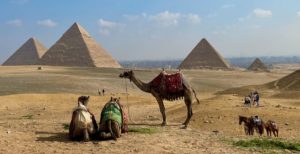
It’s 4:45 am. A monotone Gregorian chant spills into the early morning silence of our Nile River boat cabin, where I sit by the balcony window, tapping at the laptop.
Yet this chant, similar to a song on my Amazon relaxation playlist, is not Gregorian. As morning approaches over the River Nile, it’s the Muslim call to prayer. Many Egyptian Muslim men sport a darkened indent on their foreheads, in fact, from pressing their heads to the floor five times a day. Devout Muslim women pray five times a day as well, but the ladies suffer repetitive stress issues in their ankles from the prayer position they assume, according to our Egyptologist-certified guide, Neveen.
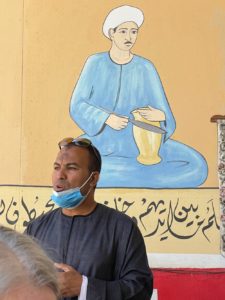

Muslim, Christian, Hindu, Buddhist: Distinct religions, whose contrasts have caused wars and humanitarian disasters since the dawn of time. In our modern era the conflicts continue. One example: Three years ago, we crossed Thailand’s border into Myanmar for a brief visit.
Since then, escalating tensions between Myanmar’s majority Buddhist population and the minority Rohingya Muslim people have escalated, and the Myanmar government continues to commit human rights abuses, despite worldwide pressure. I wonder often about the friendly people we met that day, and hope they’re still ok.
Yet how alike some religious practices seem. The Muslim call to prayer sounds like chants in Thai, Japanese, and Vietnamese temples, to prayers in St. Patrick’s Cathedral, to a chant at the end my yoga class in Key West, Florida. I’m always glad to hear the Key West chanting, by the way, since it means we’re done and I can lay with my eyes closed in corpse pose for a few minutes.

Speaking of corpses, we posed with King Tut’s! Bad us…against the rules to do that, but we got caught up and the guard encouraged us. Rules get broken here in Egypt, it seems, when tips are involved.
But I need to go back to the beginning, to our arrival in Egypt, two days after we saw the play Wicked in New York. All I could think when we walked into the Cairo terminal to a cacophony of unfamiliar languages, turbans, and flowing robes was, “We’re not in Kansas anymore, Toto.” Not making that up. That’s what I thought. Not Kansas, not Seattle, not New York. And I didn’t see a McDonald’s sign until our third day in Cairo, so not even Bangkok. Very, very different place. Wonderful and a bit unsettling, at the same time.
CAIRO ARRIVAL: CHAOTIC TRAFFIC, AND A GOLDEN PALACE
Our American tour operator, Gate 1 Travel, just started up Egypt tours again on November 2nd, so we were one of their first groups in almost two years. They were more than ready for us.

Upon arrival we moved to the first check desk for health approval. Before our trip, we couldn’t figure out exactly what we needed to present here – beyond confusing in the Covid era, but we gambled and didn’t get a Covid PCR test. It took only seconds to be cleared, as the agent glanced at our CLEAR vaccine paper copies and waved away our phones, which had three different vaccine QR codes on them. Not interested in those phones, that health agent. Almost seemed to be annoyed when others held them up. I do get that, since phones act as an extension of people’s arms nowadays, but we had multiple forms of documentation on ours, just in case.
Two Gate 1 tour guides waited for us on the other side of the health check, then ushered us through the rest of the entry process with practiced ease: Passport control, baggage claim, and to that big beautiful bus. Such a relief since of course we were jet-lagged, easily confused about the slightest thing by this point.
Correction: I get addled when tired; Padre, not so much. He’s cool under pressure. Me, I start babbling, and that’s not a successful behavior upon arrival in a foreign country. Not at all.
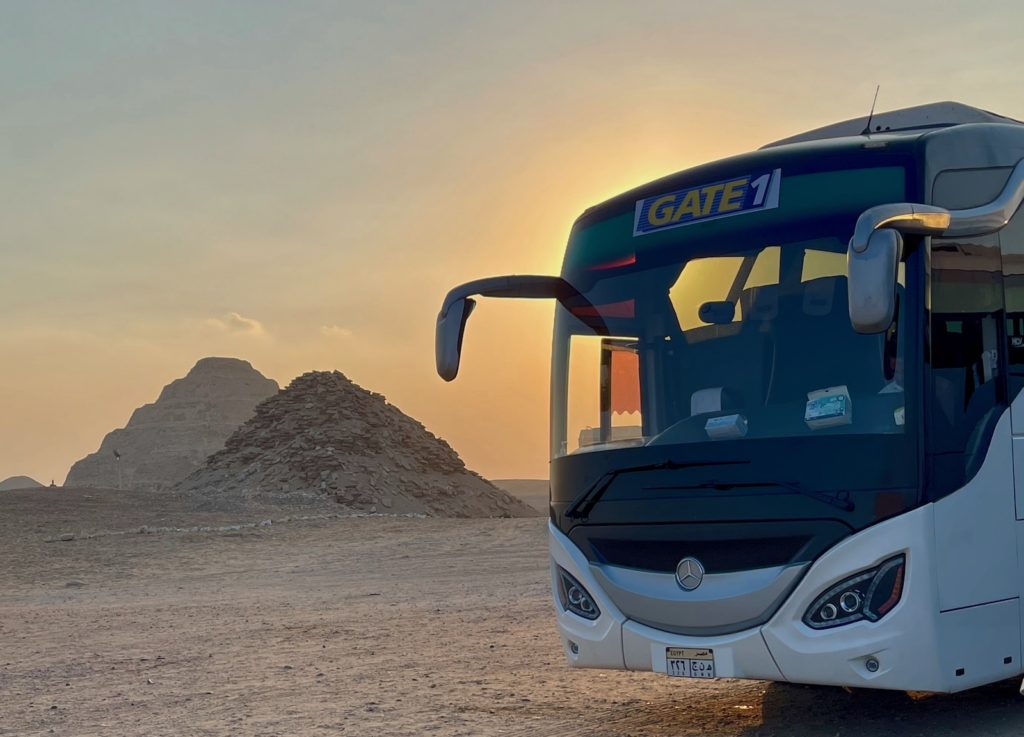
The big beautiful bus plunged into the chaos of Cairo traffic, where roads designed to be four lanes morphed into ten lanes due to the way Egyptian drivers dart from lane to lane, seeking advantage. Donkey carts joined the fray sometimes, as well as walkers, weaving among the cars.

Blaring horns, exhaust fumes, the burning yellow sun beating down during the day and the glowing moon shining over the scene at night. Whenever we took to Cairo’s streets in the big bus, chaos reigned outside the windows. Absolutely fascinating to watch, but neither of us would dare attempt a turn behind the wheel out there in Egypt driving land.
Neveen told a story of her visit to the States, when her brother forbid her to drive after a couple tries. Why? Well, she’s an Egyptian driver, so when she was in the farthest lane and saw her exit, she zipped across all the lanes at once, simple as that. Police ticketed her twice before her brother benched her. Maybe the Egyptians don’t have traffic tickets? Whatever’s going on, it looks absolutely suicidal out there.
Situated on the banks of the Nile, the Cairo Marriott was once one of the most impressive palace hotels in the world, and here is where we lodged for three nights. The Palace was built by Ismail the Magnificent, the Khedive of Egypt and conqueror of Sudan, in 1869. He built the impressive hotel to impress French Emperor Napoleon III and his wife Empress Eugenie, in Egypt to celebrate the opening of the Suez Canal. The Palace also served as a hospital during WWI, after massive casualties from the Battle of Gallipoli overwhelmed other Cairo hospitals nearby.
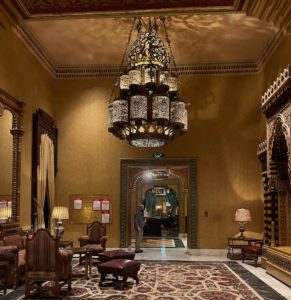
We glimpsed vestiges of the Palace’s former glory in her salons, grand staircase, and ornate ceilings, but today the hotel houses a casino, and modern twin towers frame the old Palace grounds. When our jet-lagged selves crashed on our comfy Marriott bed later that afternoon, it felt like home. (Until we heard that lilting voice on the loudspeakers calling for afternoon prayers, that is.)

Later that night we met our fellow travelers, 18 of us, Americans from Florida, Connecticut, Minnesota, New Mexico, Arizona, Seattle, all over the States. Neveen, our guide for two weeks, has been leading Gate 1 tours for 25 years, and I ‘met’ her first in a Gate 1 Egypt video I watched while travel shopping a couple of years ago.
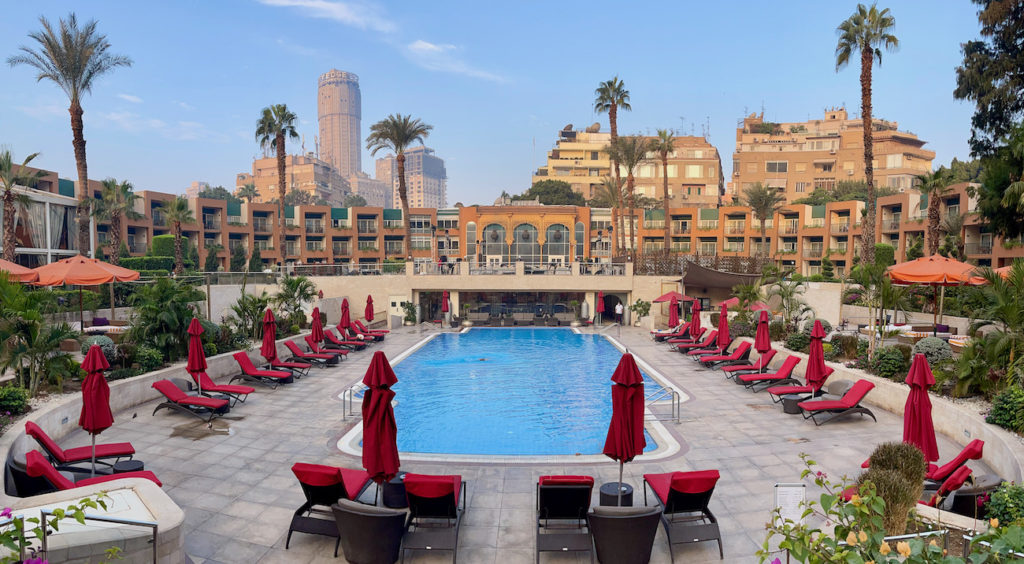
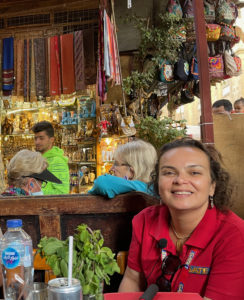
I never dreamed we’d be lucky enough to have her as our guide. When the pandemic hit, Egypt’s tourism industry crashed just like everywhere else. Gate 1 may be bringing back the ‘best of the best’ to lead their first tours after the shutdown, which certainly seems to be the case with Neveen.
Our Egyptian education began with Neveen’s instructions concerning safety, and how to deal with touts – the folks who badger tourists to buy, buy, buy, who harangued us everywhere, going so far as to hang off our Nile River boat, cooing ‘HellOOOooo, heLLOoo!’ late into the night, hoping to throw up a scarf or trinket so we will throw down cash. We did not throw down cash or engage in any way. If we had, Neveen said, they’d be outside out cabin window in the dead of night, still shouting. So no.
Even though Neveen gave us excellent advice, both of us almost succumbed to the tout’s clever manipulations at certain points later. Since they’ve seen so few tourists in the last couple years there’s an edge of insistent desperation in the entreaties, as well. The government supplemented very few salaries during the pandemic, so lord knows how Egyptian touts, or anyone, survived through all this.
But as much as these teacher/preacher types wanted to help, we refrained from passing out cash after Naveen’s warnings.
We learned protective behaviors quickly, but Naveen also cautioned us of more insidious schemes, such as the one about tickets. She said to be on guard after we’d passed through any site gate, because someone may approach us and ask for our tickets again. Do not give your ticket to them, because then they’ll say you owe them money. That particular scam came back to haunt us later.
And while the trouble with touts makes it sound as if Egypt is a very scary place, it’s not, not really. I felt safer here than at my local Walmart, especially with our security guards in tow. Our Nubian guide told us his story, for instance, of how he was a Washington, D.C. shopkeeper for years until he barely survived being shot. So he returned to his peaceful Nubian village on the Nile River. Certainly can understand that. And except for some petty thievery on the boat (not our things, but could have been), we feel quite safe traveling in our bus bubble. (So wear the money belt, as Rick Steves always says, and carry travel insurance just in case.)
And the Egyptian people we interacted with on this trip were wonderful (even the touts; some of them have a wicked sense of humor I really enjoyed as long as we kept a proper distance). Most everyone, especially the children, welcomed these American tourists back with wide smiles and relief.

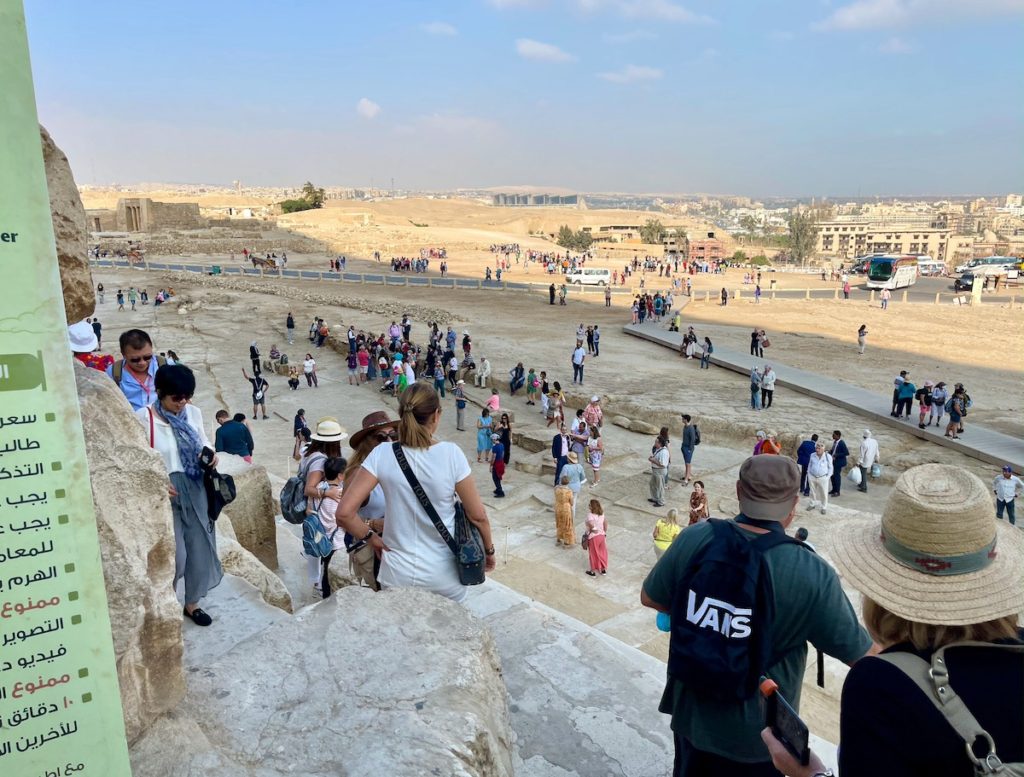
PYRAMIDS, CAMELS, AND A DEVIOUS TOUT AT THE SPHINX
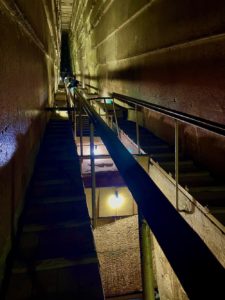
Massive pyramid building blocks stretch up to the Great Pyramid’s peak, and we climbed about 1/3 of the way up those blocks to the tiny entrance. Neveen warned us away from attempting the climb if we were claustrophobic, unsteady, or had heart issues. She did not warn us, though, about fear of heights.
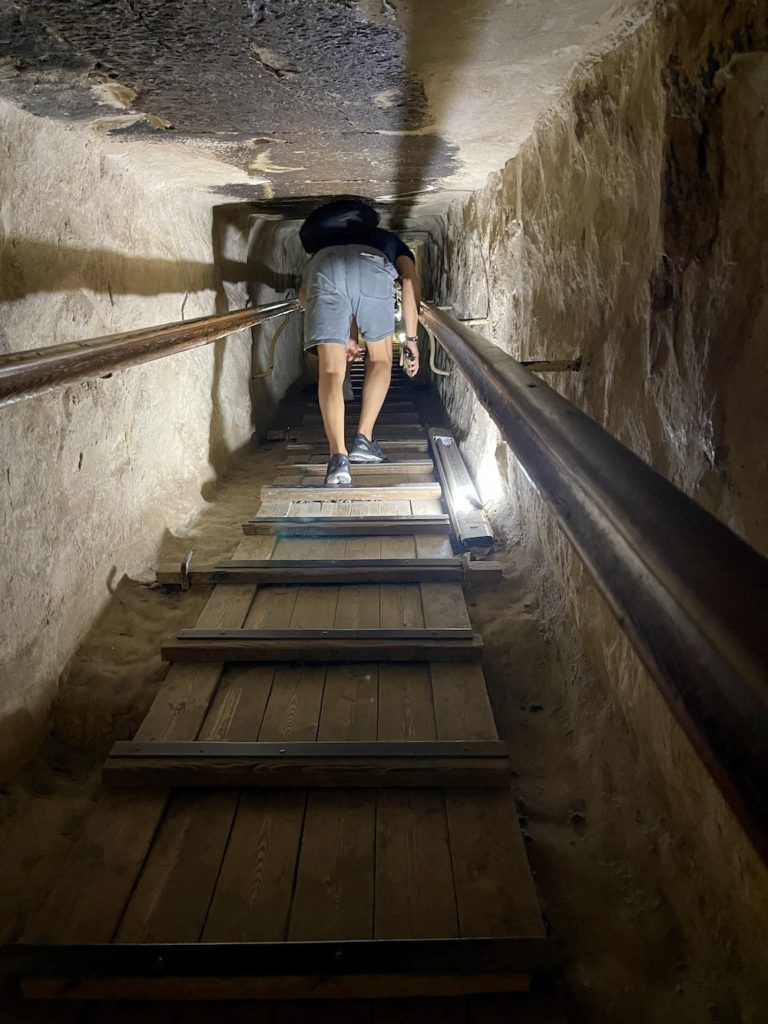
Claustrophobic, hot and stuffy: Our climb inside became all of that at one point, but was relatively easy the rest of the time since it wasn’t very crowded.
The part that got me: Going in and out, there are steps carved into the stones, but no railings. So the farther up you go, the farther you’ll fall. Excited tourists pose all over the stairways, laughing, jostling. Yikes! I clung to the rock wall, hoping some enthusiastic tourist didn’t shove me right off by accident, just for an Instagram shot. Never happen in America. We keep tourists safe, in bubble wrap almost – railings, warnings, fences. Not here in Egypt.
It was a climb, though – up and up long stairways, bending over, with tourists going up AND down. That’s when we got stuck, going down, when the flow of those going up clogged one bend in the route. So we stood bent over at the waist for the longest time, in the hot clammy tunnel, waiting. Doesn’t sound fun, but it was fun!
Not much to see when you reach the top except the eerie sarcophagus room, which Padre loved of course. The whole thing was exactly like the Great Pyramid tour I completed on the video game Assasin’s Creed, if you want to try this at home. (FYI I only bought the game for the tour. The tour leaves out the game’s gruesome violence – so not kid-friendly, that game. The tours, though, are fine. And for the history buffs out there: the game’s Ancient Alexandria Tour makes it worth the cost.
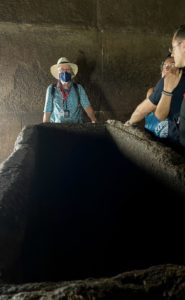
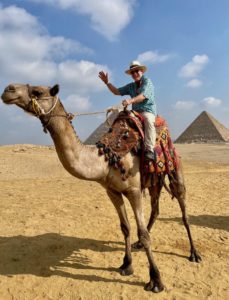

I was one of the only ones in our group who refused a camel ride. That’s because I rode a baby elephant in Thailand and still feel sad about it. But Padre was game, so I stayed behind watching the camel-ride bartering, the tourists, and of course the fascinating camels. Waaay better than a camel ride, for me.
Egyptian camel rides are serious business even though camels are never depicted in the ancient hieroglyphic record since they were a late importation to Egyptian culture. Most tourists love them, though (just not me), so Padre’s camel, in front of a pyramid? Historical distortion of the money-making kind.
Camels are rather docile creatures but will bite and kick when annoyed, a bit like some toddlers I know. And they may spit when excited. I witnessed a spitting one, whose owner calmly walked it away from the tourists for a time out. Same thing we’d all do with a tantrum-throwing toddler. Meanwhile, tourist-topped camels sauntered off in lines to the far-off golden sand dunes, and on one of them perched the Padre.
At the Sphinx we met our devious tout who showed up by Padre’s side, imploring him to show his ticket. He reached in his pocket to get it as I lunged in front of the veiled woman, saying ‘No! We’re fine!” Padre remembered then, and pulled back as the tout muttered, “What is fine?” We quickly walked away from her, shaking our heads ‘no’.
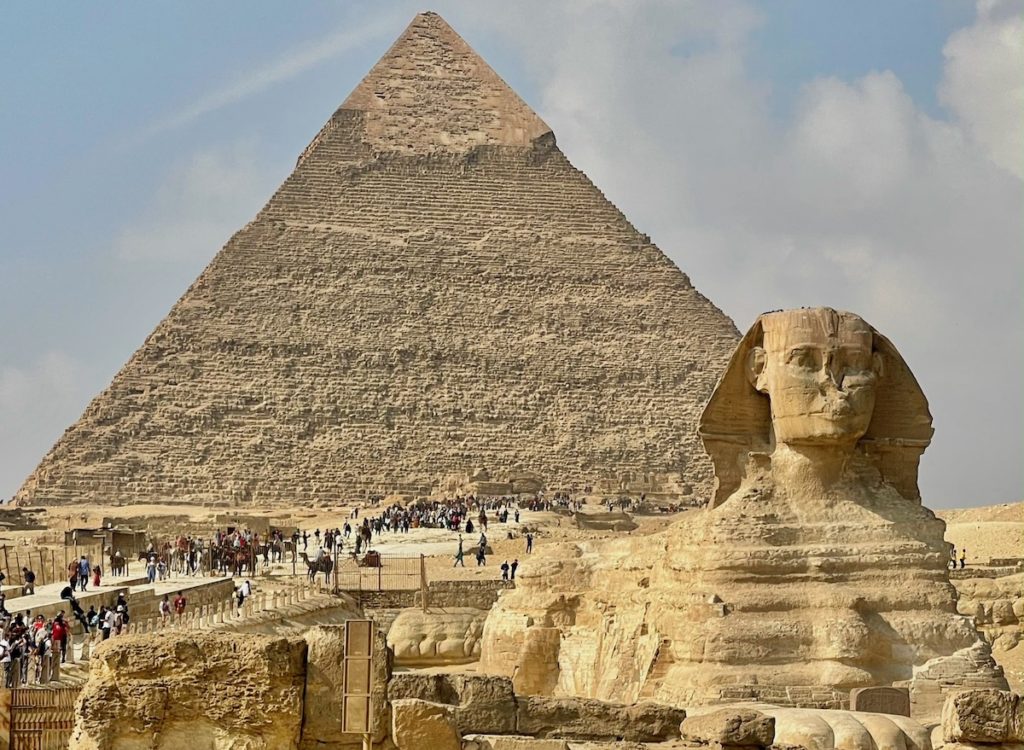

THE STEP PYRAMID AND SAQQARA: A MORTUARY COMPLEX FOR PADRE
Anyone who knows Padre knows he is fascinated with all things funereal, so Egypt is his kind of place and The Pyramid of Djoser, or Step Pyramid, 2670-2650 BC, his kind of ancient ruin. I’ll finish this post with photos of this ancient place, where we saw ongoing digs underway. Can’t wait to see what those archeologists discover next! (This fascinating Smithsonian article about recent discoveries here particularly peaked our interest.)
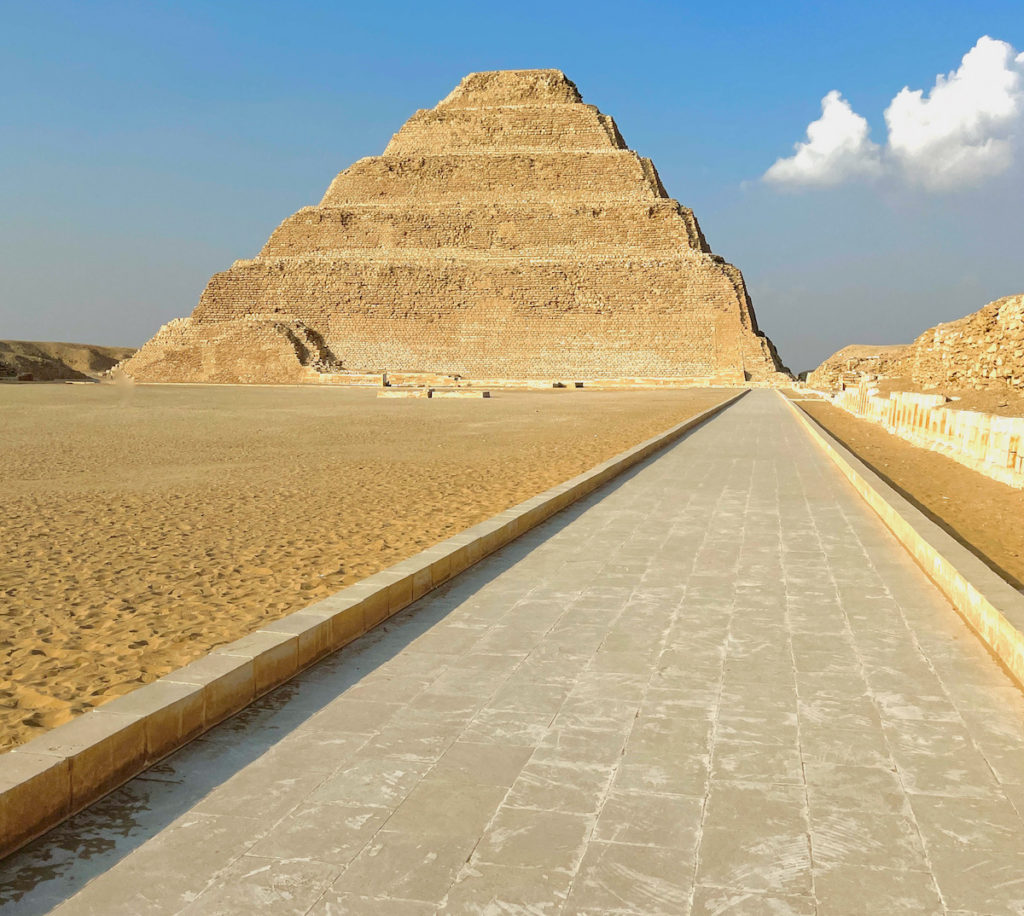
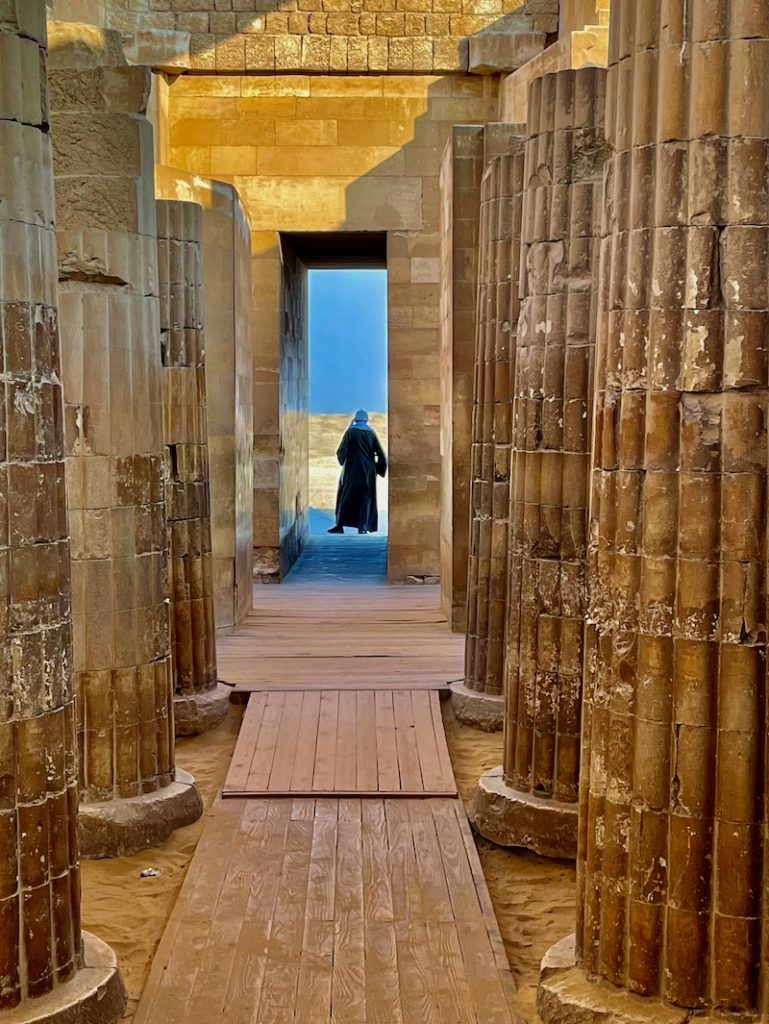
Speaking of next: Tomorrow, on to the Egyptian Museum, and the crowded Cairo Market, where locals shouted ‘Welcome back, America!’ and we tried our hand at bartering, sort-of successfully.
Thanks as always, for following along everyone!

